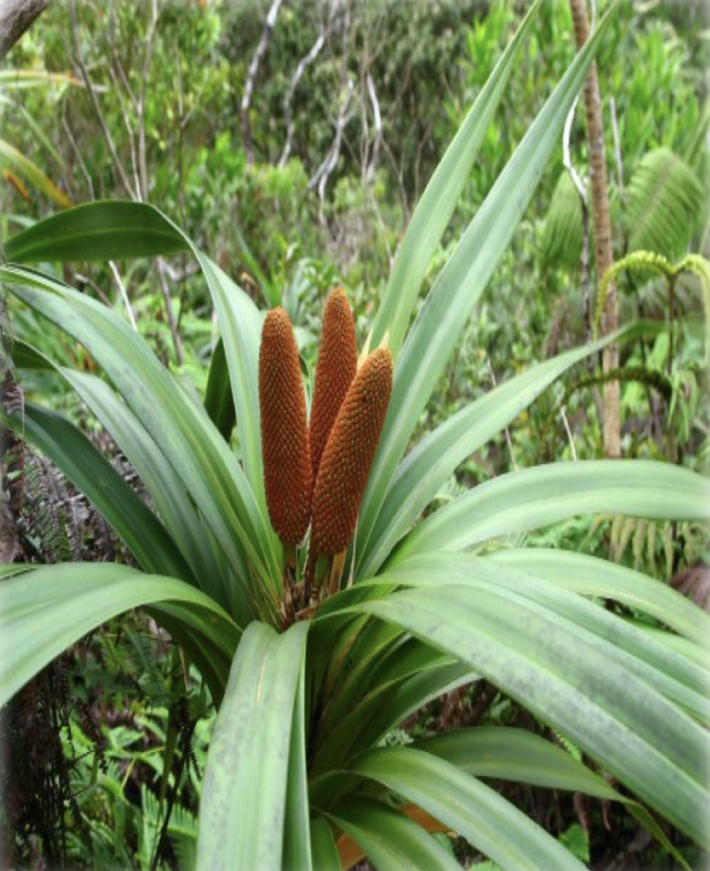In this Kūkahekahe, Cultural Specialist Kumulāʻau Sing KSK’89 shares information about ulana ʻie – the art weaving the ʻieʻie vine – as well as the cultural significance of feathered war gods.
ʻIeʻie is an indigenous plant found in our native forests between the altitudes of 1,000 to 4,500 feet. The vine can be seen growing at the tops of koa and ʻōhiʻa trees. They can have stems of about an inch in diameter and the vine has thin and pointed leaves that can grow up to two and a half feet long. At the center of the leaf cluster are rotund and elongated flowers that resemble spikes. The fruits of the vine are orange with seeded berries. Long and thin ʻie, or rootlets, extend from the stem of the vine downwards, sometimes reaching lengths of twenty feet before settling into the ground. Practitioners use these ʻie in weaving, the rootlets can take about six months to a year to mature before they can be harvested and they are collected during the summer months when drier conditions allow for safe passage in the mountains.
Although a variety of goods can be made using ulana ʻie, the kiʻi akua hulu manu (feather war gods) were some of the most elevated: these powerful ancestral images possessed immense mana and served many functions for our kūpuna. Given personal names, they were genealogically connected to ruling chiefs who passed them on to their descendants. Persons who inherited kiʻi akua hulu manu were charged with the possession and custody of the god. These deities protected their chiefs in the realm of the living and also cared for them in the next life – the realm of the ʻaumakua. They also were powerful protectors of the government and aided in times of war.
Traditionally, the kiʻi akua hulu manu were powerful manifestations of Kū, the god of warfare, medicine, fishing and politics, among other areas. These deities were created using natural materials that were gathered with purpose and intention, endowing the akua with mana and other spiritual attributes. Materials included rootlets of the ʻieʻie vine, lāʻau (such as kauila wood), niho (teeth from dogs or sharks), pā (shell), olonā (cordage and netting), hili (dye), and ʻaila (oil).
The framework of the kiʻi was woven using the ʻie, shaping the weaving into forms that approximate human figures. The hulu or feathers of birds were affixed to the woven image using fine netting that was securely tied on to the armature of the image. Because these kiʻi were kinolau, or physical representations of Kū, they were covered with hulu manu ʻula, red feathers collected from honeycreeper birds such as the ʻiʻiwi and ʻapāpane; its color evoked the blood associated with fishing and war.
Today, there are nineteen known and documented kiʻi akua hulu manu in existence. In the past, the roles and function of the kiʻi akua hulu manu included ceremonies involving death and burial, makahiki (new year) and luakini (sacrificial heiau) rituals, and warfare. When carried into war, the presence of these akua generated courage within the warriors; preparing them spiritually and psychologically for the ensuing battle. Conversely, these gods of war and sorcery would strike fear in their opponents and had the potential to bring about their destruction.
Perhaps the most well known of all akua hulu manu today is one that we have a connection to as Kamehameha Schools. Kūkāʻilimoku, Kū the snatcher of islands, was the personal war god of Kamehameha I. This akua was given to Kamehameha by his uncle, Kalaniʻōpuʻu, prior to his campaign of consolidating his rule of Hawaiʻi Island.
When I first started my journey in ulana ʻie, one of my goals was to apply my knowledge of weaving to recreate this form of ʻie. I have since woven six kiʻi over the last two decades. The beauty of creating for me is learning and applying different skills to create the image – from carving wooden pegs for the kiʻi’s eyes and affixing them against the mother of pearl shell, to lashing canine teeth for the mouth and producing kukui bark dye and applying an oil finish. In my contemporary cultural practice and when teaching haumāna, I refrain from using hulu to cover these images of Hawaiian deities in order to highlight the workmanship, artistry and the beauty of ʻieʻie style basketry which would not be visible if the work was covered with feathers.
We may never completely comprehend the full extent of the roles and functions of our ancient kiʻi akua hulu manu. However, through research and reconstruction of how these awesome images were made, we follow in the footsteps and path laid out for us by our kūpuna. Like them, we seek to coexist with the land by spiritually connecting with and having an appreciation for our natural resources collected from the ʻāina; these natural materials are what give a kiʻi “life.”

ʻIeʻie plant with flower

Kumulāʻau & Makana Sing gathering ʻie in East Maui.

Kiʻi closeup at MAMO 2019 at the MACC
TAGS
hoʻokahua,
kūkahekahe,
cultural conversations,
employee 'ohana
CATEGORIES
Kaipuolono Article, Regions, Themes, Culture, Community, Employee ‘Ohana, Ka ʻohana Kamehameha, Hawaii Newsroom, KS Hawaii Home, Kapalama Newsroom, Kapalama Home, Maui Newsroom, KS Maui Home, Newsroom, Campus Programs, Hawaii, Kapalama, Maui, Department News, Ho‘okahua
Print with photos
Print text only










